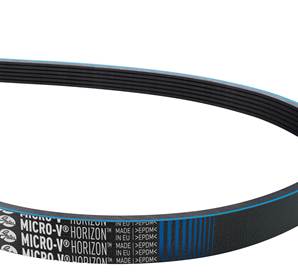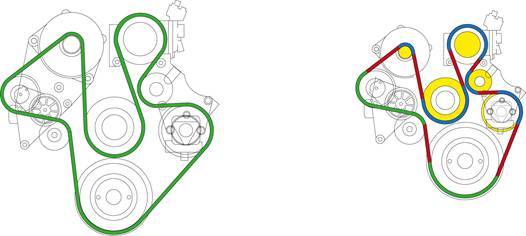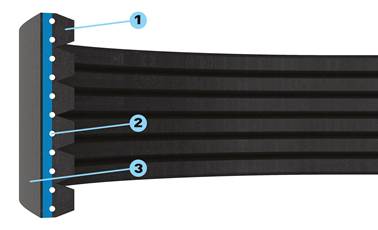Engine Drive Belts

Micro-V® Horizon™ Belt TechnologySeptember’s Automechanika, Europe’s premier event for the automotive aftermarket, was the stage upon which Gates unveiled its ground-breaking new product: the Micro-V® Horizon™. This multi-ribbed belt is the most advanced on the market and was developed specifically for the latest generation of engines, which are becoming ever more compact, increasingly powerful and which power a growing number of accessories. More compact, more demanding engines The new generation of engines may indeed be smaller than their predecessors but the opposite is true in terms of performance. The Volkswagen Golf is a good example of this. In 1990 the Golf had a maximum output of 51kW with a 1.6 litre petrol engine. By 2000 the next generation Golf was able to deliver 55kW with a 1.4 litre engine. The most recent generation is able to deliver 77kW from a 1.2 litre engine. In addition almost every car today is equipped with power steering and air conditioning as standard; however, increasingly popular accessories such as electrically adjustable seats, seat heating and in-car multimedia systems are quickly becoming the norm. Over the years the alternator has evolved in tandem, now producing 150A of charging current as opposed to 60A with considerable consequences for power transmission. Higher demands on the belt The factors detailed above have a direct effect on the requirements of the Micro-V® belt. The diagram (fig. 1) shows that it is not just the engine which has become smaller; pulleys have become smaller too. As the pulleys in the drive have a smaller diameter (yellow), the belt must also become more flexible in order to bridge the radius of rotation (blue) as this is where the belt transfers power to the pulley. The belt can cool down between two pulleys (red) but the belt has less time to do so due to a shorter free tensioning length. A more compact engine compartment leads to higher temperatures under the bonnet putting even higher demands on the belt. Fig.1
Alignment problems Incorrect alignment of the pulleys is a bigger problem in these compact engines. With an engine of the previous generation an alignment error of 1mm was not critical due to the adequate free span length between two pulleys (fig. 2). However, the same alignment error can be a serious problem for the compact engine with its short span length as the angle which the belt makes is much greater (fig. 2). Alignment problems are mainly caused by replacing only one of the components in the drive. Due to the pressure to bring new models onto the market quickly, vehicle manufacturers sometimes deliver new cars with components that are not fully aligned. It is also possible for wear in the tensioners and idlers, which may not be visible, to interfere with the alignment. These alignment problems can lead to a squeaking belt in almost all cases. The Gates DriveAlign® laser is a useful tool, helping mechanics to trace incorrect alignment. Fig.2
The Micro-V® Horizon™ belt in more detail A Micro-V® belt consists of three components (fig. 3); the undercord or rib side (1), the cord pack (2) and the overcord (3). The EPDM rubber undercord of the Micro-V® Horizon™ is reinforced with fibres. EPDM remains stable over a wide temperature range and Gates is the only manufacturer in the aftermarket which has a complete range of EPDM rubber belts. Fig.3
The compound, which Gates has developed and produced in-house, will guarantee a trouble-free operation from -40°C to +140°C. EPDM rubber is also highly resistant to oil and coolant leaks. The cord pack for belts for standard applications consists of tensile cords made of polyester. For other applications tensile cords can be made of nylon (Stretch Fit™ belt) or aramid (for extremely heavy drives). Finally, the unique overcord consists of an EPDM top layer on a tissue which increases flexibility thanks to a unique blue adhesion layer. This blue layer, based on Gates’ experiences with OE belts for the VAG group, is clearly visible on the side of the belt. The Micro-V® Horizon™ clearly differentiates itself from other belts on the market in this way. Gates has also addressed the profile and the rib angle as well as the composition. The Micro-V® Horizon™ measures only 4.2mm. This is based on the OE trend for more economical engine components with reference to Euro 5 & Euro 6. The rib angle is adapted to 42 degrees, the current Micro-V® standard in OE , for optimum guiding of the belt into the pulley. Safety comes first The ribbed belt is regarded as a critical safety component today. It drives so many different components that the failure of even one could lead to unsafe situations. No car can function without the belt, but what would happen if the belt broke down just as you were about to tackle a sharp bend? The power steering would no longer work and the driver, taken by surprise, may be unable to avoid obstacles in time. More than just a belt Apart from the quality of the belt, a great deal depends on the other components in the drive, the correct installation of components and the timely replacement of parts. For Gates, therefore, high quality products cannot be separated from the information necessary for correct installation and maintenance. The Micro-V® Horizon™ belt is therefore not a stand-alone product. You probably already know that Gates provides technical training and technical bulletins based on OE information to support mechanics. But there is more... The QR code on the packaging of each Horizon™ belt leads the mechanic straight to a dedicated website, consisting of a host of technical information. Gates has also developed an application that iPhone and Android users can use to check the condition of the belt in just a few seconds without removing the belt from the drive. Gates has also developed a new tool with which both the belt and the pulleys can be checked for wear. Horizon™ technology has actually been on the market for some time and many Gates stockists will already have the technology on their shelves without even realising it. Speak to your local factor or distributor for more information. |
Related Articles Related Downloads |


